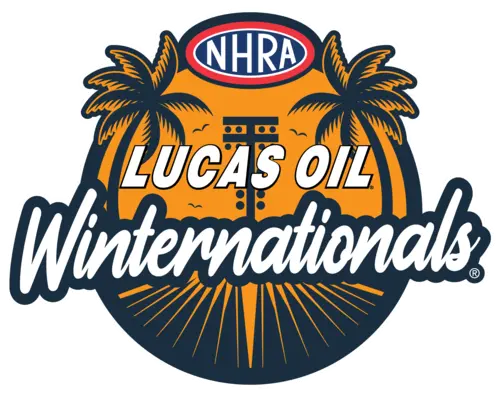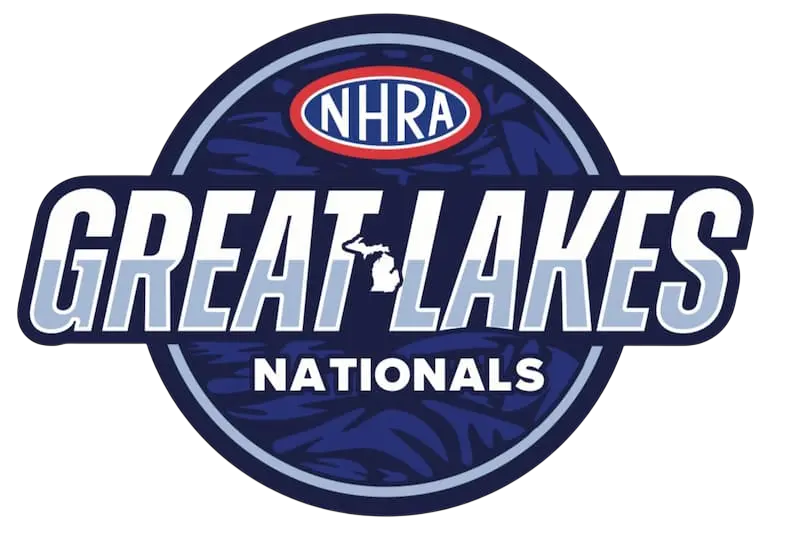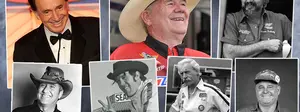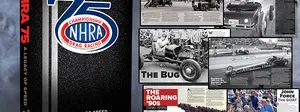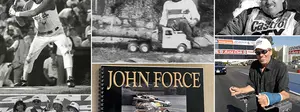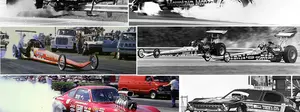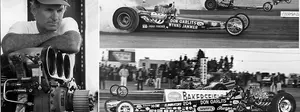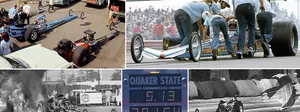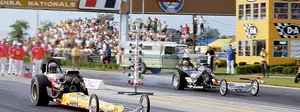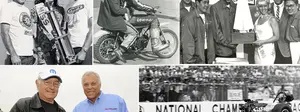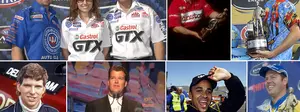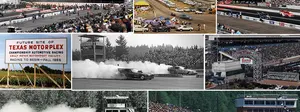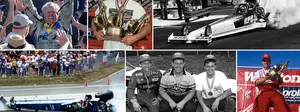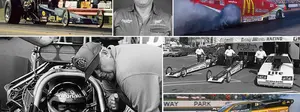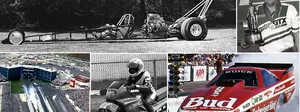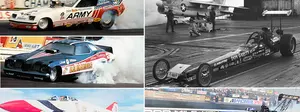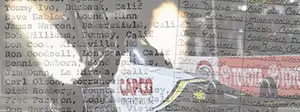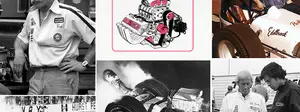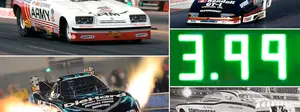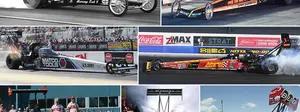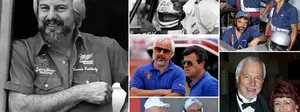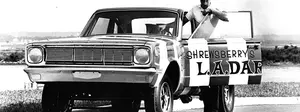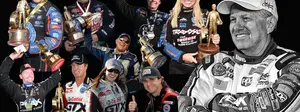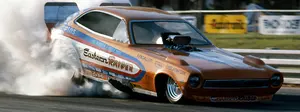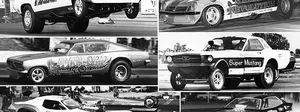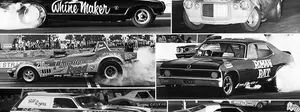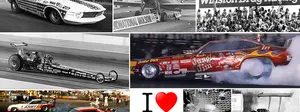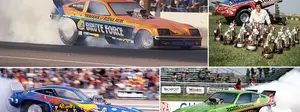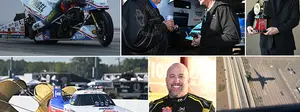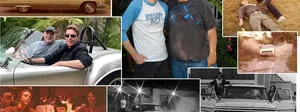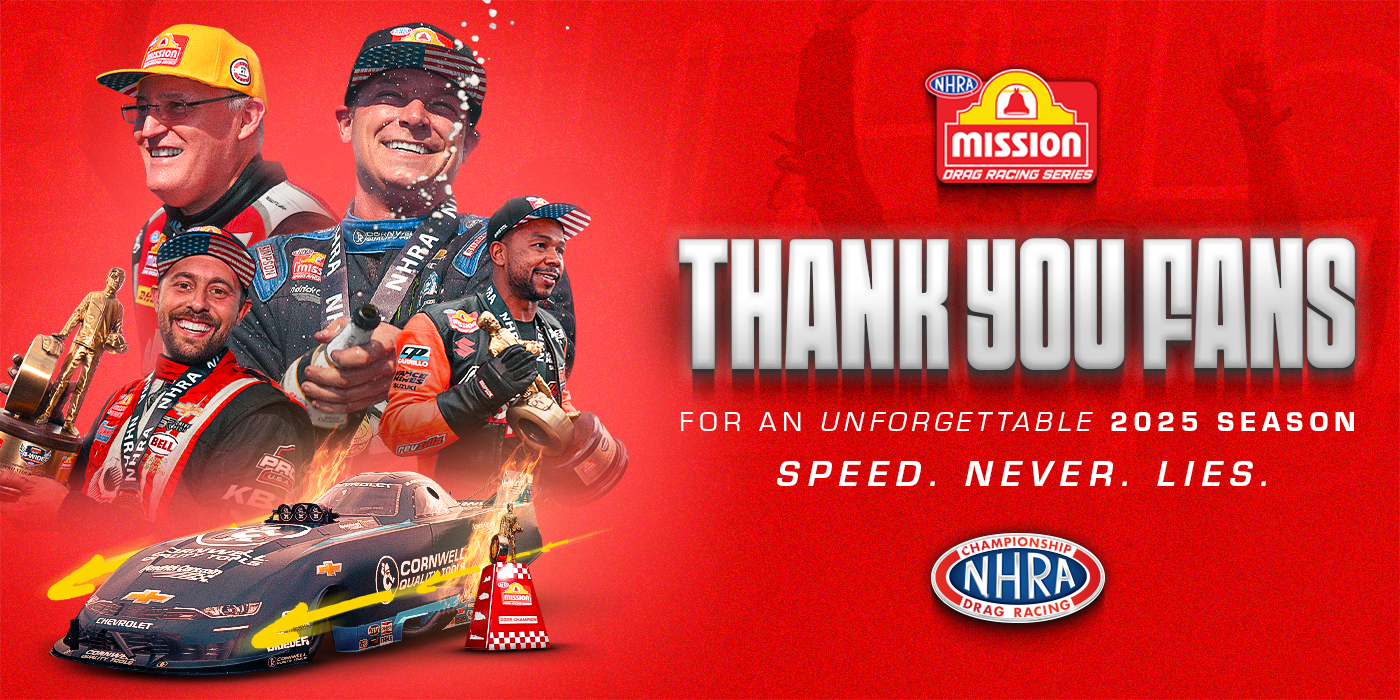

When ‘Snake’ calls … and wants to reminisce about Funny Car dry hops
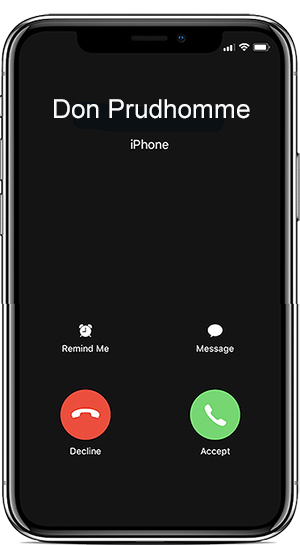
Ask any Funny Car fan from the 1970s what he or she misses most about Funny Car racing today, and I’ll bet you that the answer is “dry hops.” I know that’s the case for this old fan, and apparently, it is as much for one of the guys who mastered them, Don “the Snake” Prudhomme.
In an unplanned sequel to my recent column, “When Garlits Calls …” when the phone rang early Tuesday morning and Siri announced “Don Prudhomme” (though I still can’t get her to pronounce it correctly; working on it), it was in my hand and to my ear in a flash.
Decorated nitro wrench “Waterbed Fred” Miller who is a regular guest at many of the Casa Prudhomme get-togethers, traveling from far and wide to “be there,” explained it to me thusly: “When the Godfather calls, you come running,” or, in this case, “When the Godfather calls, you damn sure answer.”
Prudhomme had just seen a video on Facebook of his old pal, the dearly departed Raymond Beadle, doing dry hops at Orange County International Raceway (OCIR) in the early 1980s. It was just one of a number of great Super 8 movies shot by Dwight Guild, who some of you may remember I interviewed way back when (2010; read it here). You can find his complete collection on YouTube.
The video got “Snake” more revved up than a NHRA U.S. Nationals final, and he wanted to reach out to someone who probably enjoyed them as much as him. He dialed the right person.
Even though I’m 90% certain that the majority of readers of this column know what a “dry hop” is, either by seeing them live or online, I’ll briefly explain to the sadly uninitiated. Cribbing from that old column, “a dry hop was like a practice launch that Funny Car drivers would make after backing up from their wet burnouts. They often did multiple dry hops, both behind the starting line and from the line. Fans loved them because they added to the show, with two drivers and their cars snorting at one another, not unlike the age-old practice of revving your engine against another driver at a stoplight. They were a show unto themselves.”
Here's a 1982 clip from OCIR showing father and son, Jim and Mike Dunn, with dueling dry hops that should give you an idea of how long “the show” went and the different styles and number of dry hops.
The dry hop is so dearly beloved that when I wrote in 2008 about a mythical drag racing heaven where our departed heroes continue to race, I pecked out the line, “yes, there are dry hops in heaven,” which became the title of the column which is still so well remembered even today.
But back to “the Snake” …
“Man, were dry hops bitchen or what?” he asked rhetorically (as if anyone would say "no"). “Man, they were just so cool. I feel as though they're what made Funny Car so popular in the day. It was a showstopper. I get excited talking about it because it was so much fun to do them.”
Check out this clip of “the Snake” and a not-yet-famous John Force from OCIR in 1981.
Initially, the purpose of the dry hops was to check for traction — Prudhomme remembers doing them even in his automatic-transmission-equipped first floppers — but soon became an on-the-fly clutch tuning device. If the car spun on the test launch, back up and do some more dry hops to further heat and soften the clutch.
“Our first Funny Cars had the B&M automatic, so you’d do your burnout, come back, and hit it behind the starting line to make sure the tires were glued in, but it progressed into a lot more,” he remembers. “Once, we put the first clutches in — the Crowerglides — that changed everything, and we started using the dry hops to fine-tune the clutch setup on the starting line.”
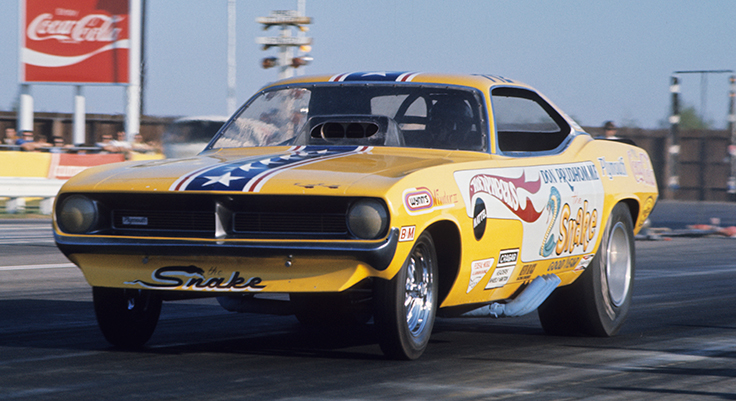
And although the ritual just seemed to grow and extend with four, five, maybe even six dry hops, it wasn’t always that way.
“There were plenty of times you'd go up there, stage it close to the starting line, and hit it there and go out about three or four car lengths,” he said. “Sometimes it would hook and you’d be ready; other times it would blow the tires off, and you'd go 'Shit,' and back it up and put some glue [liquid traction compound] under the tires and hit it again. You really wanted to get the clutch good and hot. The hotter it got, the better. I mean, sometimes you’d get it where the headers were glowing red when you got out at the other end.”
I interviewed Prudhomme’s longtime crew chief, Bob Brandt, a few years ago on this same subject (during which he credited Pat Foster as being the first to do multiple dry hops).
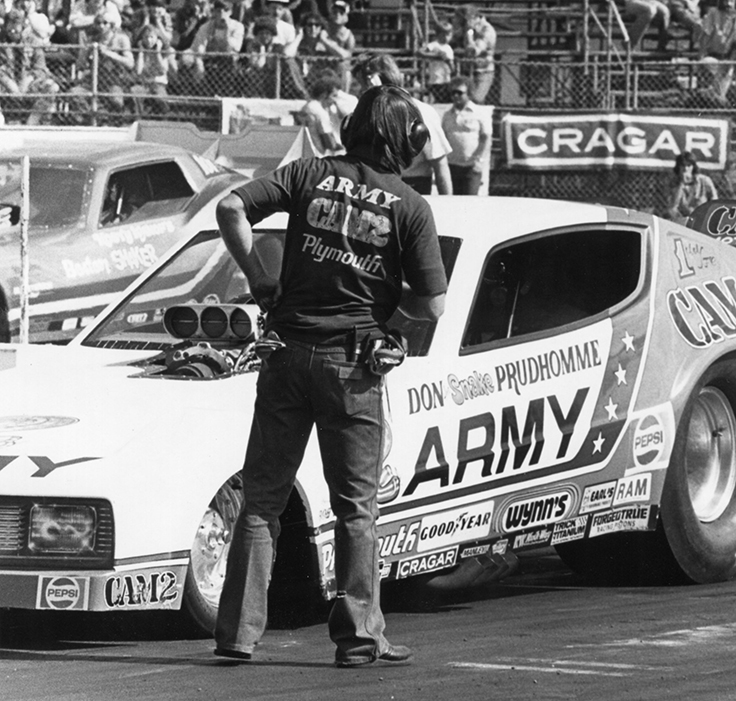
"We didn’t have the luxury of computers back then; it was all in what the crew saw and seat of the pants for the driver," he said. "We were actually adjusting the clutch with dry hops by building heat to soften it. If we had it hopped up and we smoked the tires on the dry, we knew we either had to do another dry hop, leave in high gear, or have 'Snake' try to get the car off the line with his skill. I would see what the car was doing on the dry, and if it looked like it needed more, we'd back it up and do it again.” [Full column here]
Somewhere along the line, it evolved into as much “show” as “go.”
“At first, we were more concerned about hooking the tires up, and it just happened to turn into a show,” said Prudhomme. “It wasn't by design. You're trying to get the tires and clutch worked in, and the only way you could tell was by hitting the throttle. Once you put that glue down before the last hit, you were locked in, and you're ready to go. It was the best, especially when you had it locked in and you could feel the left front tire pick up.
“One thing that people don’t think about is that it allowed you to get an idea about how well dialed in the other guy was. You could hear him over there or look out the side window and watch him. Sometimes they'd smoke the tires and you'd go, 'Good, I've got him; I've got him nailed down.'
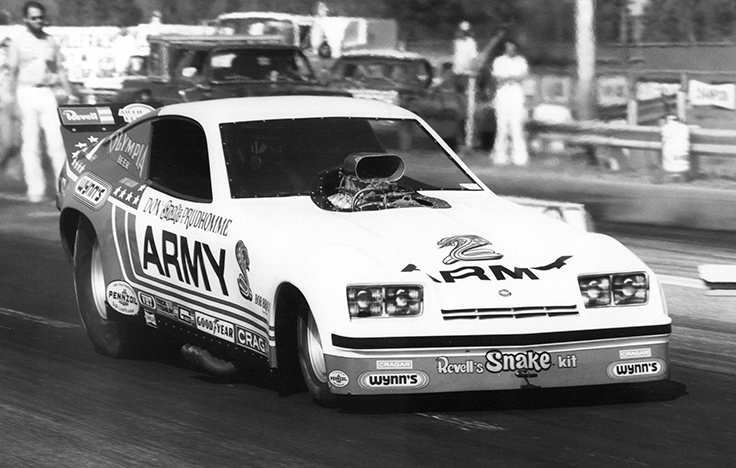
“You could also try to intimidate the guy next to you, but when I was running the Blue Max, I would watch him on my side window, and I'm going, 'Shit, that guy's badass; he's hooked up. I'm in for a race.’ “
Fans like me loved it when the drivers would rap their throttles at one another, almost “talking” to one another or a mechanical chest puffing.
“For some of those guys, I think it was monkey see, monkey do,” Prudhomme added. “Somebody who's out there hauling ass, and they had that routine, you think, 'Well, that's the hot setup; I have to do it, too.' It got pretty crazy there for a while.”
“NHRA actually got to the point where they didn't want us to do them because it took up too much time, so you couldn’t do as many dry hops or cross the starting line again. Plus they outlawed the glue and the bleach that people were using because it made such a mess. With that glue, sometimes you’d get to the end of the night and that stuff was all over the back of your car and you couldn't get it off. It was like bubblegum, you know?
“The cars are wicked fast today, of course, but it was just a lot more fun the way we used to do it, and the spectators loved it. Just loved it.”
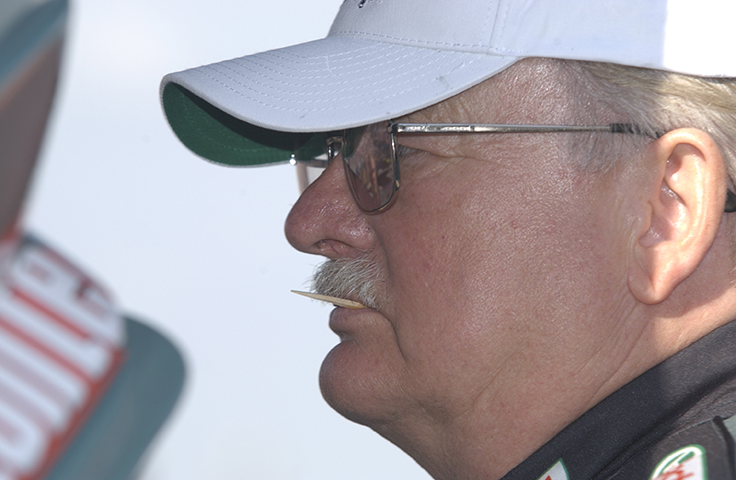
That was a fun conversation, so I thought, “What the heck; let me pass the game along,” and called Austin Coil, because when it came to being a pre-run showstopper, the Chi-Town Hustler was all about the show, right? But apparently the inventor of the long, smoky burnout and the single largest U.S. consumer of toothpicks doesn’t know the rules of “When Burgess calls …” and later returned my call, and we had another great conversation. I was surprised to hear him say he wasn’t a big fan of the dry hop and rarely used it to tune his clutch (the first Chi-Town had a Torqueflite automatic trans anyway), but, then again, he’s the genius behind 17 Funny Car world championships, so what do I know?
“We were never that much known for dry hops,” he admitted, “I think people did them because the drivers all thought it was big fun, and the crowd screamed and cheered and were obviously excited by it somewhat, and so, that's why it caught on. It was probably mostly a waste of time [mechanically], but it was all part of the show. Sometimes, after the smoky burnout, we'd back up and pour a little glue down, and do a hop out of the glue. Not a big deal.
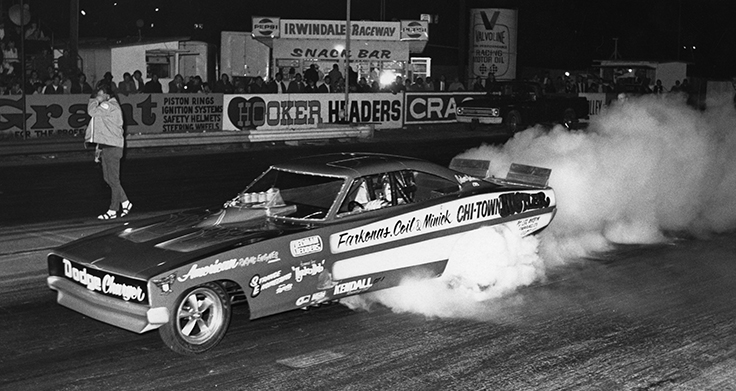
“Pat Foster was probably the king of them. He'd pull on the brake handle as hard as he could and floor it, and when he did, it'd spin the tires and stop them so violently that he'd get maybe 6 inches of air under the rear tire.
“When we did do it, it was not uncommon to do five of them, but remember, we ran mostly match races in those early days, and we usually had already poured [powdered rosin] on the track, so we were actually working in the powder.”
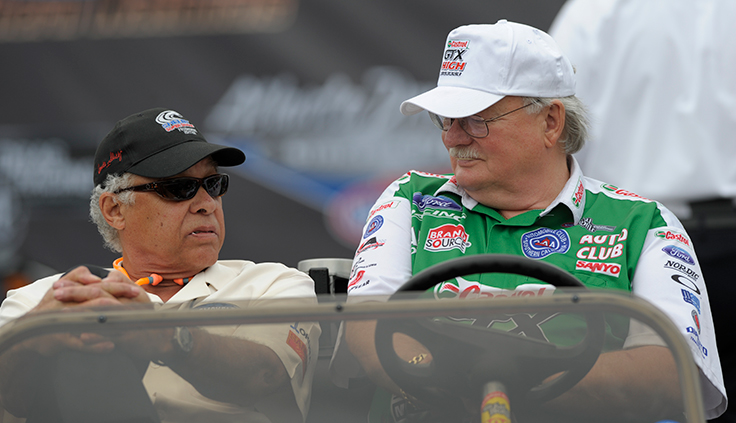
As clutches became more sophisticated along with the advent of direct drive, the dry hops ended almost as surprisingly as they had begun.
“It probably didn't do any harm, but when the clutches became a weak link and we were melting the floaters, the idea of putting any extra heat in it was obviously stupid,” he added.
Vintage Coil. No punches pulled.
Ed McCulloch, another of the fabulous flopper drivers who lived through the dry hop era, also started with an automatic transmission in the first Whipple & McCulloch Camaro and, as Coil said, did the hop to coat the tire in the glue.
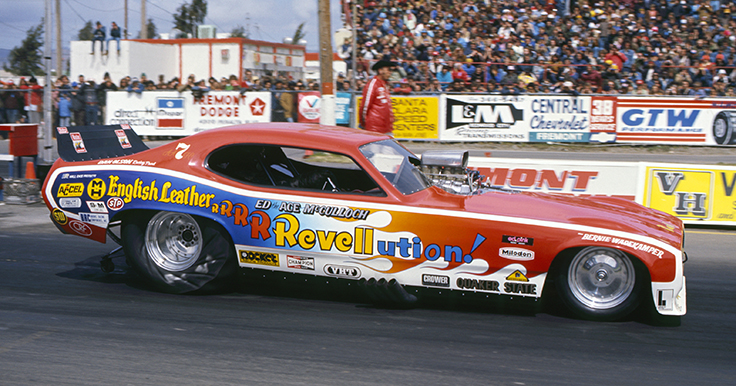
“You'd do a burnout, back up, and pour the glue down, then you'd hit the throttle and chirp it, just spin the tire in the glue, and then chirp it another couple of times, so it's not moist on the tire, then pull up there and go,” he said. "If the car didn’t stick on the last dry hop, you could leave dragging the brake or you could squeeze into the throttle to get it going, which was a lot easier to do back then because of the throw of the throttle pedal. Today, it’s like 2 inches; back then it was probably 6 inches, so you could drive a car with the throttle a lot easier.
“But the dry hops were fun. There were a lot of times where you did more based on who you were competing against. One guy would chirp it, and then the other guy would chirp it, and it's sort of like they're talking back and forth to one another. It was just part of the overall show. It was a fun thing to do, like, ‘Who's gonna get the last word here?’ You were always trying to outdo the other guy. I've done burnouts where I crossed the finish line, put it in reverse, and backed up almost as fast as I did going forward.
“Today the teams try to keep the heat out of the clutch, but back then, we wanted to put heat in the clutch. I always did my own clutch in the early years, and you see what they do today: It's fresh floater plates, every surface is reground flat, and the discs are all flattened from one run to the next.
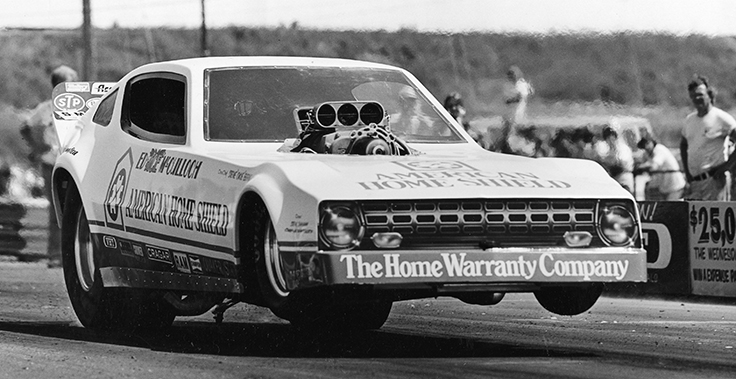
“Back in the day, you never pulled the clutch out at an event. Crower made these little shims that would slide down in if you wanted to adjust the pack. You could loosen the hat and go around the six stands and pull a shim out at each stand to close the pack up like 20-, 30-, or 40-thousandths. You didn't ever take the clutch out of it, but during the week, you'd take it out and fix all this stuff because it's warped and not flat. You'd put it on the ground and take a body grinder to it because back then we didn't have clutch grinders.
“Sometimes I would notice that the floater plates would be tight on the stands, so I’d take a grinder and clearance the lug, the notch in the floater, to where it would slide. I never stopped to wonder, 'Why did that get tight?' It got tight because it expanded from the heat. Sometimes you could see the stress cracks in it, but you could spray spark plug cleaner on it and see how bad the cracks were. If they weren't too bad, you'd go ahead and put it back in and run it again. Well, they kept growing and growing and growing, and the stupid thing was, we didn't realize it's growing because it's trying to come apart, and the only thing that's holding it in there is those stands. I look back and ask myself, 'Why were you so stupid to not know that?' “
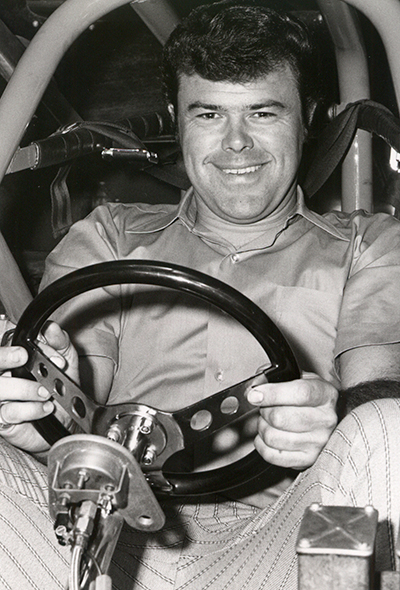
“Ace” also shared a funny anecdote about that first Funny Car. He had raced Top Fuel starting in 1964 but switched to Funny Car in 1969, and was immediately uncomfortable in his new ride.
“Art Whipple bought our first Camaro from Richard Schroeder, and it was a blown big-block Chevrolet on fuel, and it had an automatic transmission in it,” he said. “When I sat in that car, it was the most terrible feeling I ever had in my life. I was used to dragsters where you're all tucked in and the roll cage is right there, and the steering wheel is right there. That Funny Car, with those wide cages, was like taking a dining room table and sitting it out in the living room. You could reach out with your hand and hardly reach the roll cage, and it had a big ol’ round steering wheel on it. I didn’t even know how to shift it or anything, but I talked to some people, and we won the first race we went to, and I guess that sort of set the hook.”
There's no doubt that those dry hops had their special place in the long and storied history of the Funny Car class, that they were a tool of necessity in an era before today's high-tech, multistage clutches and controllers. Long, smoky burnouts disappeared as tire compounds shifted and crew chiefs put tight controls on the engine running-time limit to be able to exactly predict clutch temperatures to natch the rest of the tune-up. There simply is no leeway for unscheduled shenanigans like dry hops.
But dry hops were very much a staple of the match-race scene back in the day, back when a driver to team's ability to wow the fans beyond pure performance could mean the difference between a packed docket of booked-in paydays or meandering the country surviving on bologna sandwiches.
You look at masterful showmen like "Jungle Jim" Liberman and "TV Tommy" Ivo, guys whose list of NHRA national event accomplishments could easily fit on half of a folded-up McDonald's napkin, and contrast that with the drawing power of their show, from fire burnouts to "Jungle Pam" to glass-sided trailers, that allure kept them hustling and raking in appearance money year 'round. "Jungle Jim" arriving late from some distant previous booking, unloading quickly, and then driving his running car from the pits to the track was all part of the magic that resonated with fans and promoters.
Phil Burgess can be reached at pburgess@nhra.com
Hundreds of more articles like this can be found in the DRAGSTER INSIDER COLUMN ARCHIVE
Or try the Random Dragster Insider story generator





